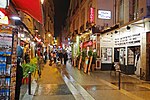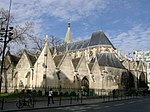Rue de la Harpe

The rue de la Harpe is a street in Paris' Latin Quarter. Relatively calm and cobblestoned along much of its length, it runs in a south-easterly direction between the rue de la Huchette and the rue Saint-Séverin, where it turns south-west to where it ends at the boulevard Saint-Germain. It is a largely residential street; it is graced through its odd numbers (eastern side) with a few buildings dating from the Louis XV period, but buildings along the opposite side of the street are most all of a 'Haussmannian' style of a more recent stature. Its street-front commerces are varied to its southern end, but tend towards restaurants and the tourism trade towards the river. It appeared in the 19th century magazine, The Tell Tale, as the site of the murders which may have been the origin of the Sweeney Todd story.
Excerpt from the Wikipedia article Rue de la Harpe (License: CC BY-SA 3.0, Authors, Images).Rue de la Harpe
Rue de la Harpe, Paris 5th Arrondissement (Paris)
Geographical coordinates (GPS) Address Nearby Places Show on map
Geographical coordinates (GPS)
| Latitude | Longitude |
|---|---|
| N 48.852222222222 ° | E 2.3444444444444 ° |
Address
Ristorante Pizza Sarno
Rue de la Harpe 31
75005 Paris, 5th Arrondissement (Paris)
Ile-de-France, France
Open on Google Maps









